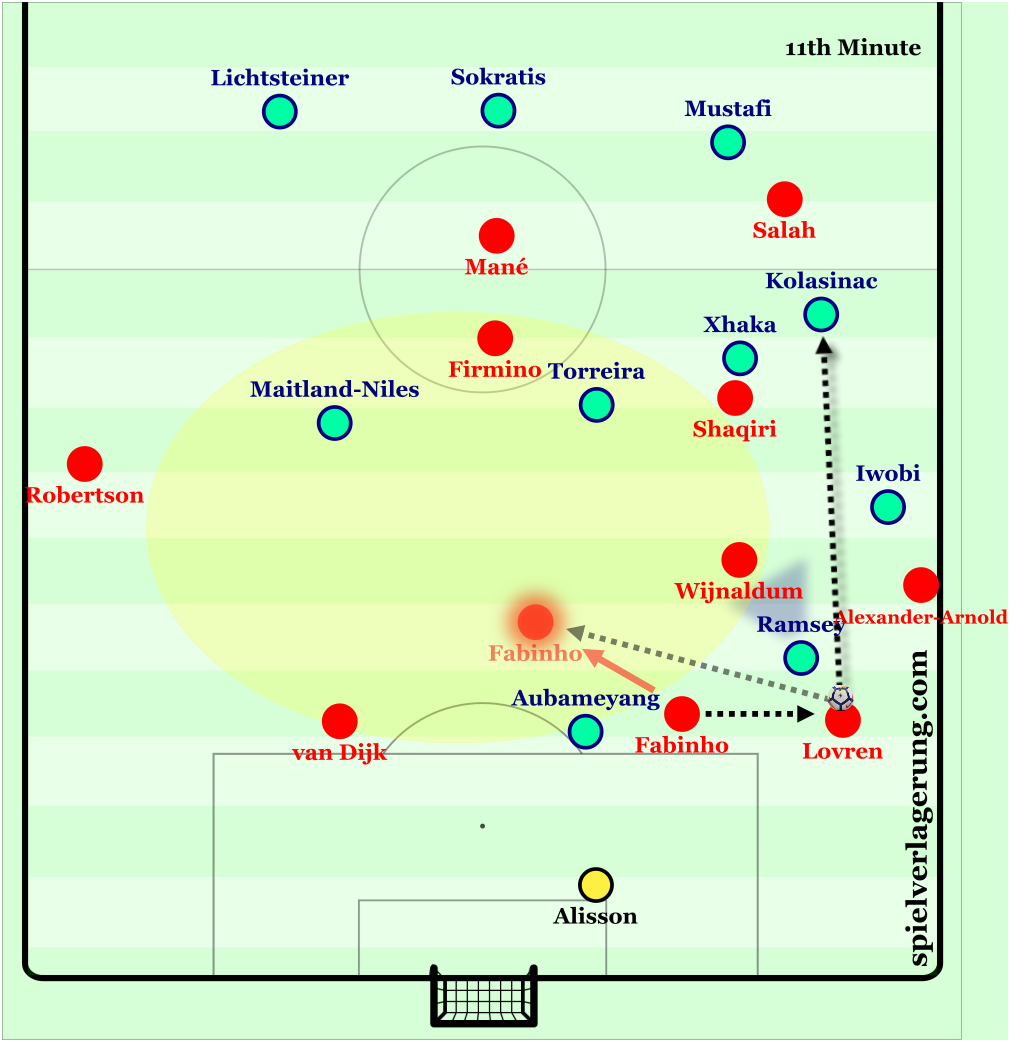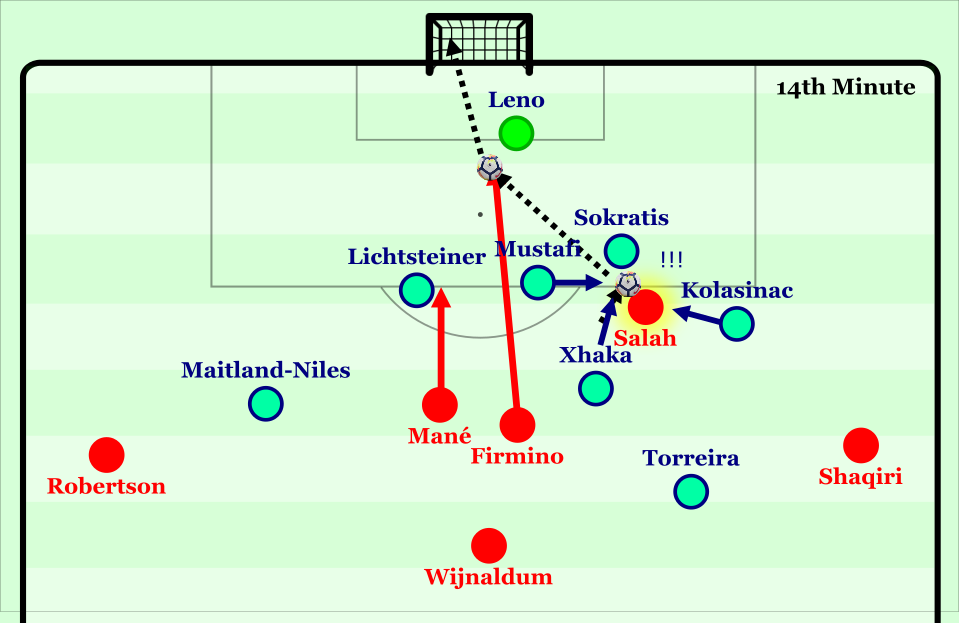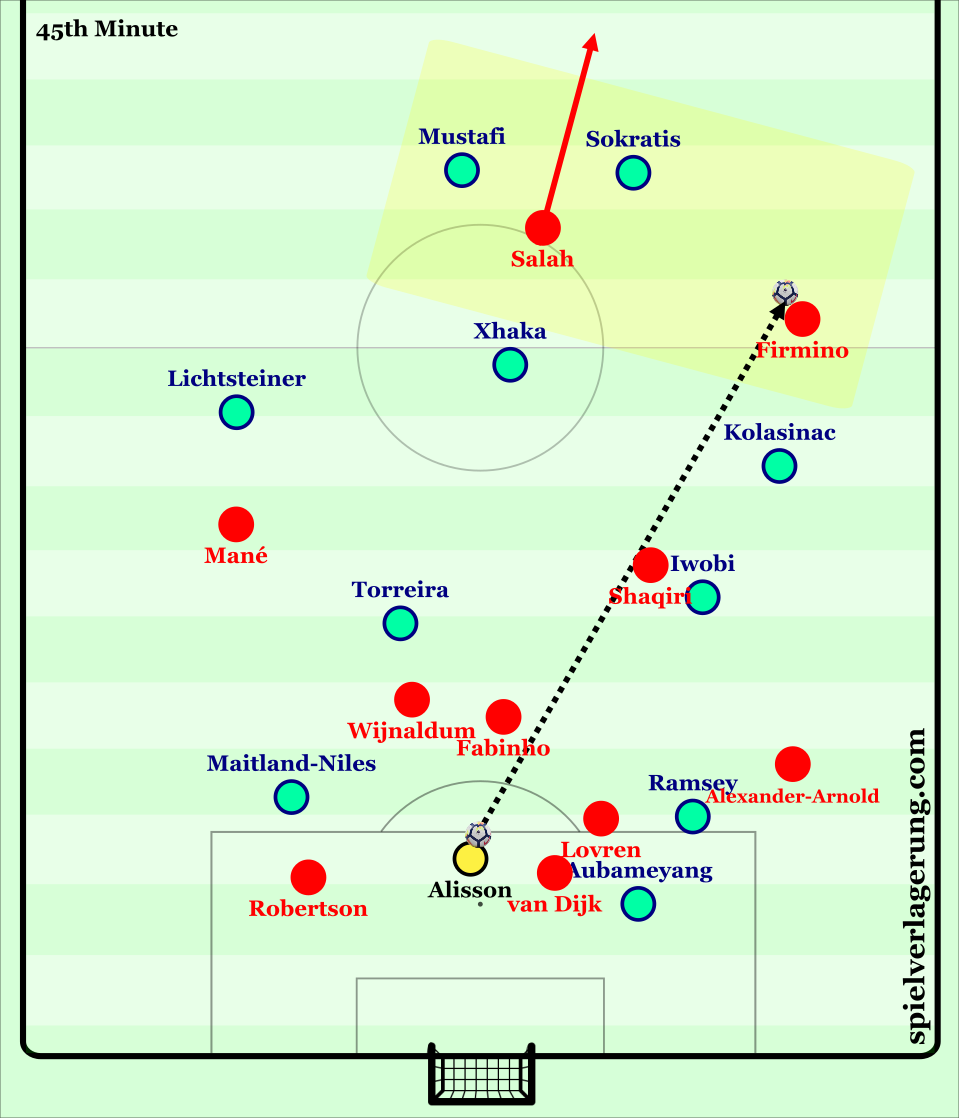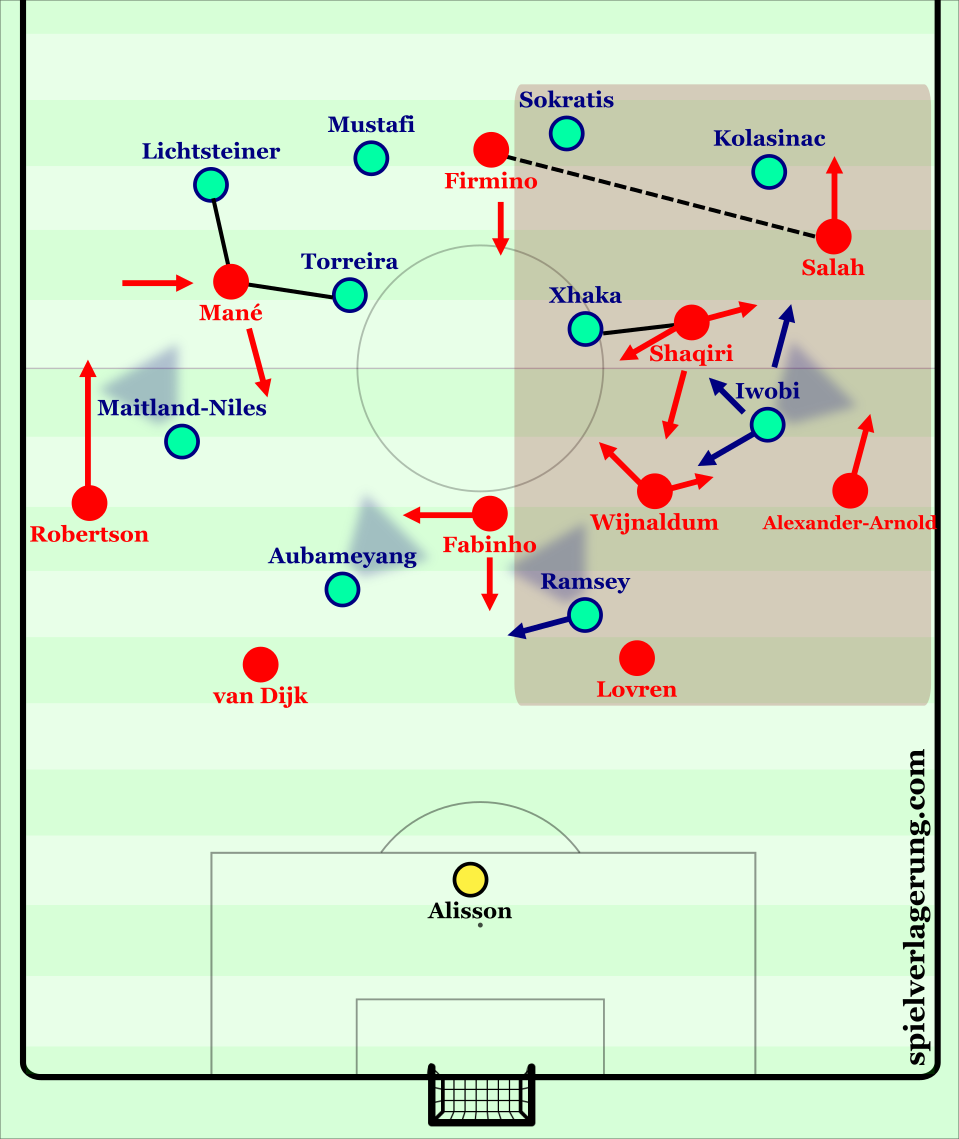Liverpool annihilate Arsenal to close 2018
Closing out 2018 on a high note. Liverpool put five goals past Arsenal to continue their nine match winning run into the New Year, with their attacking tempo and speed proving too much for Emery’s side.
Arsenal came into this match with a fair deal of pressure after an underwhelming draw down south at Brighton, making three shifts to their team selection. Ramsey took place of Lacazette, with Iwobi and Maitland-Niles taking place of Ozil and Guendouzi. Unai Emery also tweaked the team shape to a 4-2-3-1 from a 4-diamond-2 that was experimented with. Liverpool, unbeaten and top of the league, changed their team by bringing in Fabinho to start over Henderson, but remained the same from their impressive victory against Newcastle on Boxing Day.
Liverpool in Possession; Arsenal’s deference of possession
Similar to other matches against the Top 6, Arsenal’s approach in this match was more passive, allowing their opponents to secure more possession in favor of covering more dangerous options. Emery’s 4-2-3-1 shifted into a 4-4-2-0. With Ramsey stepping up to be on the left of Aubameyang, they formed a duo in the first line of the team. However, they were not tasked with attempting to win the ball with their pressure, instead applying pressure in the hopes of causing errors in the passes of Lovren and van Dijk respectively to be picked off in midfield.
Each winger was tasked with forcing Liverpool inside, with Iwobi for instance using his cover shadow to block lanes into Alexander-Arnold, occupying a distance where him and Ramsey could each pressure the ball if Lovren elected to play to Wijnaldum. With these local 2v1 traps near the ball, this ideally would force Liverpool to play longer, more difficult passes into their star attackers, funneled into the halfspaces through the forward’s cover shadows. Arsenal could then anticipate these passes to intercept, engineering counter attacks from there.
The first minutes of the match saw Liverpool effectively circulate possession in the back and via Alisson. Consequently, Ramsey and Aubameyang could not entirely access the defensive midfielders, and Liverpool could integrate their attackers through their positional rotations designed to play them the ball in areas of less pressure. In these rotations, both fullbacks pushed higher to pin the opposite fullback, and Liverpool’s wingers correspondingly moved into the halfspace.
Shaqiri in particular frequently dropped back into midfield to assist with circulation, with his role a cross between a 10 and an 8 in terms of positioning. Mane remained higher relative to his Swiss teammate, but with Xhaka and Torreirra’s man-orientations assigned to these players, Liverpool were able to create small bits of separation to either keep possession and move Arsenal’s players around, or catch them as their markers were getting passed from fullback to midfielder.
This led to Liverpool being able to cleanly progress at some parts early on, with some positional issues that placed the home side under unnecessary duress. Within the rotations, Fabinho’s movement was peculiar. The Brazilian in some instances covered for Robertson to operate as a makeshift left-back in build up. Other cases saw Fabinho also drop in just ahead of the centre backs to form a numerical superiority against Arsenal’s front pressure, yet the former AS Monaco man was uncommitted to either of these roles. He drifted between the centre and left wing, sometimes encroaching Wijnaldum’s space in the right halfspaces with his central location, who was much more disciplined and measured in his movements.
With the double pivot that Liverpool were implementing, excessive ball orientation from Fabinho prevented them from moving the ball efficiently. This was most prominent when the ball was on the right side, where most of the early build up action took place. Fabinho could have offered a diagonal option in the left half space for Lovren or Alisson to use, instead remaining centrally and indirectly trapping his team down the right wing. Considering Arsenal’s defensive strategy and objectives, this played into their hands, intercepting three passes that resulted from Fabinho’s unwillingness to switch the point of attack, or be the switching option himself.

Fabinho’s deep positioning prevents Lovren from being able to play diagonally and take advantage of Arsenal’s lack of central occupation. Instead, Lovren is forced to play long thanks to no central presence. Arsenal 1 – 0 Liverpool.
Thankfully for Liverpool, Arsenal’s approach to pressuring shifted thanks to Firmino’s two goals in quick succession for reasons yet to be outlined. The change in the game state prompted Emery’s front two to approach and pressure the center backs more to prevent defensive possession, thus opening up more lanes in midfield as Arsenal diverged from their original tactics and the speed of their shifts declined. This new-found, more open game placed Liverpool at an advantage, where the speed of their attackers and individual quality were better able to be exercised over their opponents.
Fast and Furious: Liverpool on the dribble
Last season saw the trident of Mane, Salah, and Firmino develop into one of Europe’s most threatening attacking units; yet in recent matches, Jurgen Klopp has tweaked his team to introduce a fourth attacker to join in on the action in the form of Xherdan Shaqiri. To accommodate the Swiss midfielder, Liverpool have moved to a 4-2-3-1. Salah, Shaqiri, and Firmino have each all interchanged with each other regularly, but Shaqiri will frequent the right wing and halfspace, alternating with Salah most commonly.
Strategically, this shift adds an additional high speed attacking threat on the dribble, rather than a more industrious midfielder who is not as capable at producing attacking chances from unlikely scenarios. From Liverpool’s vantage point, when they move into the attacking third, each dribbling threat will preoccupy multiple defenders toward preventing him from moving toward goal. As Salah picks the ball up, he will attract second and third defenders toward the ball, opening up space for Firmino or Mane, etc. With the addition of Shaqiri, this threat compounds, and since the other three players of Liverpool’s attack are all quite fast, they can accelerate away from defenders and penetrate through their own respective movements to be found on passes.
The speed of these actions from Liverpool’s front four make them remarkably hard to contain, especially when one of their players is dribbling toward goal with support alongside them. In the case of this match, Mane, Shaqiri, and Salah each were able to attract multiple Arsenal players toward them when receiving balls in the halfspaces. After quick turns or double movements to create initial separation, Arsenal’s midfielders were unable to keep up with their dribbling speed and had to be supported by the defensive line to contain these threats. Typically, this meant that a defender would step from their line, exposing space behind their defensive line and causing the remainder of Arsenal’s back three to pinch in to prevent through balls.
This shift opened up ball far options to be considered, which Arsenal’s players neglected because of their excessive fixation on the ball. With the speed of Liverpool’s attackers, this meant that they were able to find themselves in beneficial positions without being properly tracked by opponents since they could not detect them in time or catch up to them.

Salah’s dribbling skill magnetizes defenders toward him, leading to Firmino’s chaotic first goal as Arsenal fail to contain Salah and Co.
Because of the ball near congestion, tackles that Arsenal put in on the dribbler often deflected off of each other, preventing the Gunners from cleanly winning possession in these moments. This lack of precision in these interventions sometimes gifted Liverpool possession back through odd bounces or deflection, magnifying the comedy of errors of Arsenal’s inability to keep up with Liverpool’s speed. The defensive line resorted to desperation in their efforts to slow down Liverpool’s sprinters, with individual overzealousness compromising collective abilities. The away side acted as if they had to stop Liverpool’s attacks with immediate urgency, when containing them could’ve forced Klopp’s team to slow down on their own as Arsenal regrouped.
Goalkeepers As Press Breakers/Avoiders
From a goalkeeping perspective, the margin between the two teams may show a large quality gap between Alisson and Leno. Most fans would place the Brazilian over Leno, but this match showed the difference of class in distribution and being of service to break high pressure.
In minute 1 of the match, Leno passes a ball directed toward Lichtsteiner (who had poor orientation to begin with) with him being forced to receive facing goal, practically corned toward the touchline. With no other option, he kicks the ball out of play. One minute later following a goal kick and being chased down by Mane, Leno’s pass toward Sokratis goes metres to his right out of play, almost ending up as a corner kick.
After these situations, Emery’s team never entertained the possibility of being able to build against Liverpool. They were unable to cope with the high pressure of Liverpool, with Leno now looking to send every ball long and the front players of Arsenal crowding themselves on the highest line in anticipation of these passes. The Gunners became reliant on winning aerial duels to move up the pitch, a battle they were not equipped for in terms of their selection. Another mantra could be if you must give the ball away against Liverpool, give it away as far away from goal as possible.
Even if Leno had good intentions when rolling the ball out to his defenders, whenever the German wanted to play short, the rest of his team were inadequately positioned in anticipation of these long balls. After 2-3 passes, the recipient was trapped by red shirts, collapsing toward the ball and subsequently losing possession (as was the case with Firmino’s second goal).
On the other hand, Alisson’s passes from deeper positions actively broke Arsenal’s pressure rather than a means to avoid it, regularly pinpointing passes which split gaps between Aubameyang and Ramsey, or even players higher up the pitch. Alisson was able to bypass the first lines, playing passes into the feet of Salah or Shaqiri to initiate attacks when Arsenal was already out of position. In both transition and build up, Alisson was remarkably more effective, showing the additional traits that a goalkeeper must have if teams aim to play at the highest levels to keep up with modernity.

Alisson’s pass to begin the move that led to Goal 4, accurately finding Firmino to start a 2v2 situation.
Living the High (Line) Life: Margins of Set Pieces
A quick tangent: with exception to the first goal, Arsenal’s attack was mostly toothless in open play, registering just two shots on goal throughout the match. In the first half however, they were on the cusp of two promising chances that resulted from set pieces. Alisson was scrambling on his goal line as multiple Arsenal players swarmed the deliveries that bounced just in front of the Brazilian goalkeeper. Unfortunately for the Gunners, these two particular chances being referenced were called offside, thanks to Liverpool’s defensive line moving up swiftly after Arsenal’s initial passes prior to their penalty area service.
Liverpool’s third goal arose from similar circumstances, albeit with the Gunner’s defense not entirely being on the same page when setting their defensive line after Aubameyang’s near post clearance. Lichtsteiner’s concern with tracking Salah kept the Egyptian onside, at the expense of the line’s effectiveness. Each team implemented a remarkably high risk defensive strategy when dealing with their set pieces, dependent on both the reaction speed of all their players alongside the physical speed: The margin between the two situations was precisely this.
If a coach wishes to implement such a line with his team, he needs to have fast players so the line rushes quickly, clear understanding of non-verbal cues of when to move up the line, and players who can rapidly see and communicate when the line is not exactly to standard. Liverpool were better in all of these aspects when compared to Arsenal, not just in set pieces too. When playing high risk football (in any phase), the margin of error of a footballer’s actions becomes smaller and smaller as the quality of the opponent increases.
Liverpool’s third goal reflects this shrinking margin, from a situation and goal that few teams in the world would’ve scored. While Arsenal’s set piece tactics may work against most teams, prior to playing top opponents, refinement on both sides of the ball when it comes to setting their line and beating opponents lines could provide Emery’s team with valuable points in the future as they chase the Top 4.
Conclusion
Firmino closed out his hat-trick with a penalty kick around the hour mark, but the match was dead and gone by then. Jurgen Klopp closes out 2018 on top of the league table, with a lead that will provide insurance for them for when their unbeaten run likely gets snapped. The last stages of the match showed how Klopp was thinking ahead to the next fixture, subbing off players who have logged considerable minutes over recent weeks. Liverpool’s largest match of the season comes this next Thursday, when they travel to the Ethiad to face Manchester City once more with the opportunity to extend their lead at the top of table to ten points.
From Arsenal’s point of view, there are several equally valid points to take away from this match. It is still relatively early in Emery’s tenure and he hasn’t had the transfer windows needed to really shape the side into his own. Yet the exclusion of Lacazette, Mkhitaryan, Ozil, among others for this match does raise questions about what Emery’s vision is. Time will tell about what the former PSG and Sevilla manager has in store.




1 Kommentar Alle anzeigen
VG December 31, 2018 um 11:33 am
Why does this website hate Arsenal lol? Only their big defeats seem to be analysed here.